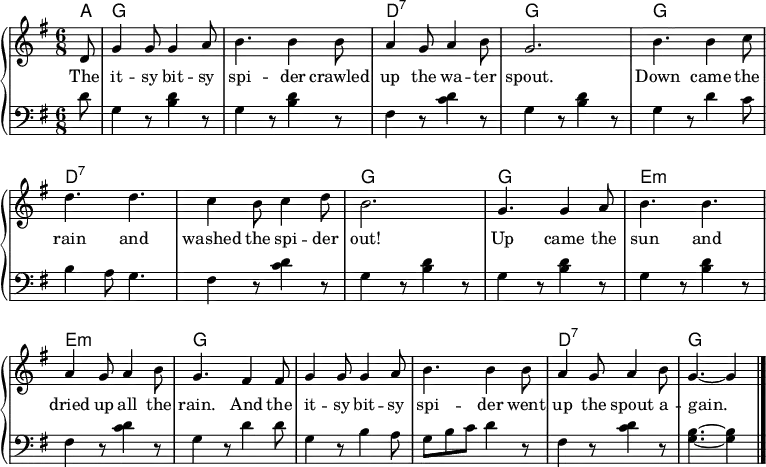Itsy Bitsy Spider
"The Itsy Bitsy Spider" (also known as "The Incy Wincy Spider" in Australia,[1] Great Britain,[2] and other anglophone countries) is a popular nursery rhyme, folksong, and fingerplay that describes the adventures of a spider as it ascends, descends, and re-ascends the downspout or "waterspout" of a gutter system or open-air reservoir. It is usually accompanied by a sequence of gestures that mimic the words of the song. Its Roud Folk Song Index number is 11586.
Throughout this article, the North American title and lyrics are used to ensure consistency.
Lyrics
A commonly used version uses these words and gestures:[3]
| Words | Fingerplay |
|---|---|
The itsy bitsy spider climbed up the waterspout. |
Alternately touch the thumb of one hand to the index finger of the other. |
Other versions exist.
Sources
The song can be found in publications including an alternative version in the book, Camp and Camino in Lower California (1910),[4] where it was referred to as [the classic] "Spider Song."[5] It appears to be a different version of this song using “blooming, bloody” instead of "itsy bitsy". It was later published in one of its several modern versions in Western Folklore, by the California Folklore Society (1948),[6] Mike and Peggy Seeger's, American Folk Songs for Children (1948).[7]
Lyrics as described in 1910 as being from the 'classic' "Spider Song":[5]
Oh, the blooming, bloody spider went up the spider web,
The blooming, bloody rain came down and washed the spider out,
The blooming, bloody sun came out and dried up all the rain,
And the blooming, bloody spider came up the web again.
A slightly earlier version recorded in 1909 in Indiana recorded from a college commencement more closely resembles the most common modern version:[8]
There was a blooming spider
Went up a blooming spout
And down came the rain
And washed the spider out
Out came the sun
And dried up all the rain
But that bloody blooming son of a gun
Went up that spout again
The song is sung by and for children in countless languages and cultures. It is similar to the melodies of the children's songs "Sweetly Sings the Donkey" in the United States, and "Auf der Mauer, auf der Lauer", "Ich bin ein kleiner Esel" (the German-language version of "Sweetly Sings the Donkey") and "Spannenlanger Hansel" in German-speaking countries.
Score

Recordings
The popular nursery rhyme has been covered and sampled a number of times.
- 1980: Patsy Biscoe (as "Incy Wincy Spider") CD: 50 Favourite Nursery Rhymes Vol. 1, also available as 3-CD set 150 Favourite Nursery Rhymes[9]
- 1986: Carly Simon on the Heartburn film and on the Coming Around Again album
- 1988: Carly Simon on the Greatest Hits Live album
- 1989: Nicole Kidman on the Dead Calm soundtrack (as "Incy Wincy")
- 1991: Little Richard on the Disney CD For Our Children, to benefit the Elizabeth Glaser Pediatric AIDS Foundation[10][lower-alpha 1]
- 1995: Danish-Norwegian pop band Aqua, then known by their original band name Joyspeed, released a single only "Itzy Bitzy Spider"
- 2002: The Mars Volta sampled the rhyme on their song "Eunuch Provocateur" from their extended play Tremulant
- 2002: Raffi sang this song on his Let's Play album by adding an additional verse
- 2002: Joey DeLuxe during the credits of the 2002 film Eight Legged Freaks
- 2006: EliZe feat. Jay Colin released "Itsy Bitsy Spider" on the album In Control
- 2013: Maziar Bahari's company Off-Centre Productions created an animated version of the song featuring an animated mouse character named "Journo"[12]
- 2021: Lyn Lapid (single)[13][14]
See also
References
- "Watervale Notes". The Northern Argus. Clare, South Australia. 21 December 1944. p. 7. Retrieved 8 July 2023 – via Trove.
- "Nursery rhymes and songs: Incy wincy spider". BBC School Radio. Retrieved 8 July 2023.
- "Words to The Itsy Bitsy Spider". www.datsplat.com.
- North 1910.
- North 1910, pp. 279–280.
- Hansen, Marian. "Children's Rhymes Accompanied by Gestures," Vol. 7, No. 1, p. 53
- Vaughan Williams Memorial Library Online search Archived 2013-03-15 at the Wayback Machine, retrieved 19 August 2010.
- "Evening Session, Thursday, February 15, 1912". Proceedings of the Convention of the Indiana Sanitary and Water Supply Association – Proceedings of the Fifth Annual Convention. 15–16 February 1912. p. 105.
- Biscoe, Patsy (1980), Patsy Biscoe's 50 favourite nursery rhymes, Rigby, ISBN 978-0-7270-1366-8
- "Disney - For Our Children". Retrieved 28 September 2023 – via www.allmusic.com.
- Greene, Andy (May 9, 2020). "Flashback: Little Richard Plays 'Itsy Bitsy Spider' on 'Full House'". rollingstone.com. Retrieved September 28, 2023.
- "Itsy Bitsy Spider", Off-Centre Kids Productions on YouTube
- "Itsy Bitsy by Lyn Lapid". Retrieved 2021-02-01.
- "Lyn Lapid - Itsy Bitsy". Retrieved September 28, 2023 – via www.allmusic.com.
Notes
- Richard had performed the song on the "Little Richard Too Late" episode of the American television sitcom Full House in 1994[11]